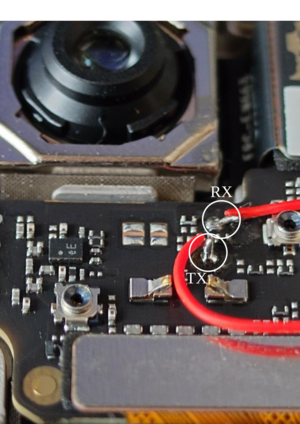Nothing CMF Phone 1 (nothing-tetris)
Appearance
(Redirected from CMF by Nothing Phone 1 (nothing-tetris))
 A CMF Phone 1 device, on the postmarketOS splash screen. | |
| Manufacturer | Nothing |
|---|---|
| Name | CMF Phone 1 |
| Codename | nothing-tetris |
| Model | A015 |
| Released | 2024 |
| Type | handset |
| Hardware | |
| Chipset | MediaTek MT6878 |
| CPU |
4x 2.5 GHz ARM Cortex-A78 4x ARM Cortex-A55 |
| GPU | ARM Mali-G615 MC2 |
| Display | 1080x2400 AMOLED |
| Storage | 128/256GB |
| Memory | 6GB (only in some markets)/8GB |
| Architecture | aarch64 |
| Software | |
Original software The software and version the device was shipped with. |
Android (Nothing OS) 14 |
Extended version The most recent supported version from the manufacturer. |
Android (Nothing OS) |
| FOSS bootloader | yes |
| postmarketOS | |
| Category | testing |
Mainline Instead of a Linux kernel fork, it is possible to run (Close to) Mainline. |
yes |
pmOS kernel The kernel version that runs on the device's port. |
6.18 |
Unixbench score Unixbench Whetstone/Dhrystone score. See Unixbench. |
10,090.4 |
| Device package |
|
| Kernel package |
|
Flashing Whether it is possible to flash the device with pmbootstrap flasher. |
Works
|
|---|---|
USB Networking After connecting the device with USB to your PC, you can connect to it via telnet (initramfs) or SSH (booted system). |
Works
|
Internal storage eMMC, SD cards, UFS... |
Works
|
SD card Also includes other external storage cards. |
Broken
|
Battery Whether charging and battery level reporting work. |
Broken
|
Screen Whether the display works; ideally with sleep mode and brightness control. |
Partial
|
Touchscreen |
Broken
|
| Multimedia | |
3D Acceleration |
Broken
|
Audio Audio playback, microphone, headset and buttons. |
Broken
|
Camera |
Broken
|
Camera Flash |
Broken
|
| Connectivity | |
WiFi |
Broken
|
Bluetooth |
Broken
|
GPS |
Broken
|
| Modem | |
Calls |
Broken
|
SMS |
Broken
|
Mobile data |
Broken
|
| Miscellaneous | |
FDE Full disk encryption and unlocking with unl0kr. |
Broken
|
USB OTG USB On-The-Go or USB-C Role switching. |
Broken
|
| Sensors | |
Accelerometer Handles automatic screen rotation in many interfaces. |
Broken
|
Magnetometer Sensor to measure the Earth's magnetism |
Broken
|
Ambient Light Measures the light level; used for automatic screen dimming in many interfaces. |
Broken
|
Proximity |
Broken
|
Haptics |
Broken
|
Primary Bootloader Whether it is possible to replace stock bootloader with U-Boot. |
Works
|
|---|---|
Secondary Bootloader Whether it is possible to chainload U-Boot from stock bootloader. |
Works
|
Mainline Whether latest upstream versions of U-Boot are not broken and it is possible to use them. |
Works
|
Internal Storage Whether it is possible to boot from internal storage (e.g. eMMC or UFS). |
Works
|
SD card Whether it is possible to boot from SD card. |
Broken
|
USB Host Whether it is possible to boot from a USB storage or connect a keyboard. |
Works
|
USB Peripheral Whether it is possible to use device as a peripheral in U-Boot, e.g. for fastboot mode. |
Works
|
Display |
Works
|
Keyboard |
Works
|
Buttons Whether it is possible to navigate in boot menu or grub with volume and power buttons. |
Partial
|
| This device is based on the MediaTek Dimensity 7300. See the SoC page for common tips, guides and troubleshooting steps |
Contributors
- BotchedRPR
Users owning this device
- Adomerle (Notes: Mainlining)
- BotchedRPR (Notes: Mainlining, u-boot, etc.)
- Frost I7 (Notes: Stock)
How to enter flash mode
- Fastboot mode (U-Boot): Hold down the key after the device vibrates.
- Boot menu: Hold and until you see a "NOTHING PHONE INFO" boot menu.
- Fastboot mode: Enter the boot menu, select fastboot with and enter with
- Recovery mode: Enter the boot menu, select recovery with and enter with
Installation
0. Unlock your bootloader, by going into Developer Options in Android, and toggling OEM Unlocking on, then booting to Fastboot and running
$ fastboot flashing unlock
$ # now agree on your device with the Volume Up key
1. Select the device in pmbootstrap and run install as normal.
2. Install Das U-Boot. It's available here. To flash, use:
$ fastboot flash lk <path-to-u-boot.img> reboot
3. Your device should reboot and display the U-Boot logo, as well as a note that it is in Fastboot mode.
4. Now you can flash the device with pmbootstrap, like normal.
$ pmbootstrap flasher flash_kernel
$ pmbootstrap flasher flash_rootfs
$ fastboot reboot
5. Enjoy postmarketOS!
Device quirks
- Fastboot appears to not work properly if the device is plugged into the host when entering fastboot mode. In this case, any fastboot command will halt seemingly forever and without action. A command can still be executed by unplugging the device, issuing the command, and then reconnecting the cable; or simply by rebooting to fastboot again without a cable connected. (Has to be verified the bug still exists under u-boot)
- This device uses a new flashing protocol, unsupported by mtkclient. It can read partitions, but flashing fails (and yes, I am alive is real and comes from device.):
[SEC_POLICY] lock_state = 0x3
Security deny for [lk_a].
I am alive.
UART
UART can be accessed on the motherboard, close to the camera (requires disassembly). The pins operate at 1,7V.
